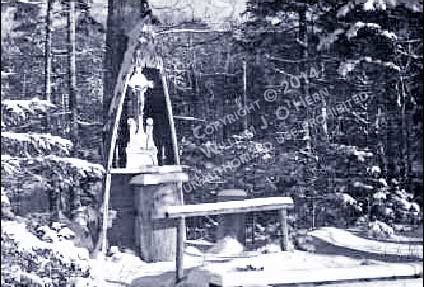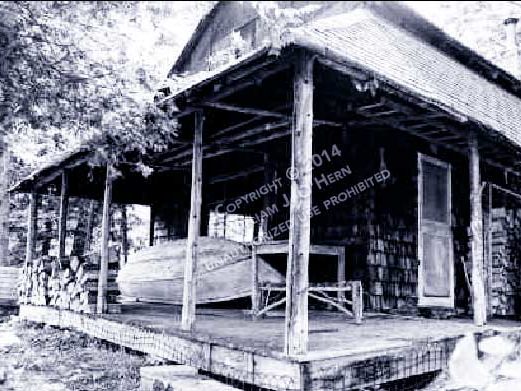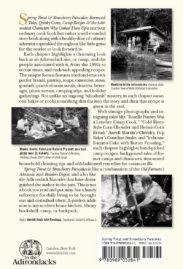Nature offers a balm for all ills and a solution for all problems. Life at Nat Foster Lodge was a relaxed and heartening experience

Spring Trout and Strawberry Pancakes
We lived at Nat Foster Lodge
An excerpt from ” Spring Trout and Strawberry Pancakes “, Starting on page 28.
Melancholy incident to record this day! Last evening the largest and best of the trout were reserved for use at the frugal meals to be served on this last day. They were placed in a pail in the spring with proper weights; said weights being some soaked “hard bread rocks.” But alas! On His Holiness’s going to the spring this morning to get a trout for breakfast, they were gone. An otter or some other varmint of the woods had robbed the deposit of its fishy treasure. Proof that it was not a man, but an animal who committed the theft is evident by the fact that six bottles of Dominican ale in the spring were untouched!
—A.L. Byron-Curtiss, July 28, 1905
MY WIFE, BETTE, and I have always loved spending time in the Adiron- dacks, and for a long time it had been our fondest dream to do so through an entire year. However, all we had for shelter was a backpacking tent— hardly sufficient long-term housing against inclement weather and vora- cious black flies and mosquitoes.
Our solution was to rent the former Nat Foster Lodge, once owned by Rev. Byron-Curtiss, for one year.
The interior had changed little in the years since the holy man had sold the camp to Tom and Doris Kilbourn in the early 1950s. The only major enhancements Tom had added were gas lights, a propane refrigerator and cook stove, a small shower and a hot water heater.
Living there, mostly on weekends, made for a terrific outdoor life. We had shelter during storms, took canoe trips right from the camp’s beach, enjoyed the warmth of a wood fire when we returned in cold weather, enjoyed the sounds and sights of the loon dance in the path of moonlight and felt the presence of the former owner. Nature offers a balm for all ills and a solution for all problems. Life at Nat Foster Lodge was a relaxed and heartening experience.

1947. St. Catherine’s Outdoor Chapel, Nat Foster Lodge, North Lake.
Courtesy Jeb Brees
Food preparation was a snap at Nat Foster Lodge too. We had the conveniences of home within the walls of a rustic camp. Bette and I enjoyed reading the extensive notes in the camp’s log books, and learned that over the decades Byron-Curtiss’s camp opening routine had always included leveling the foundation under the front portion of the camp, cleaning the mice nests out of the cook stove, inspecting and cleaning the stove pipes, “slicking up” the camp’s interior, sawing down trees into blocks, collecting limbs and driftwood — and replenishing the ever-dwindling woodpile.
Wooden boat repairs were many. They needed to be moved from storage and repaired. Just moving the weighty boats down a makeshift ramp and into the water was more than a one-man job.
Docks, of course, needed yearly attention, and other carpentry projects big and small never seemed to diminish. The weight of winter’s snow on his structure and the action of frost on the “upright,” constructed from salvaged lumber that was not always the best to begin with, ensured yearly rebuilding and repairing.

Mike and Dianne O’Hern. April, 1998. Soon after this picture was taken, the author and his son Mike took the canoe out on the lake. Mike accidently tipped the canoe over, spilling the paddlers into the cold water. Soup and Nat Foster Lodge’s box stove warmed the campers up.
Author’s Collection
The addition of the fireplace in 1930 was the last major remodeling job the owner undertook.
And, there were the myriad tiny details a non-camp owner might never give a thought to: “Put new oar locks on boat. Built a saw horse. Put yellow trim on big boat and proper lettering on Omega.” There were also the necessary but mundane jobs of washing clothing with scrub board and tub, washing windows, daily cleaning of the kerosene lamp globes and trimming wicks, putting up muslin screens over the windows, and tending to sewing and mending tasks.
Those jobs were not part of our experience at Nat Foster. We enjoyed the leisure to just recreate and use the facilities. About the only chore, if it could be called that, was to bring drinking water from a trusted spring, a mile away on the opposite shore. The job was easy, filling large water containers and then driving them to the camp. It reminded Bette of her childhood days when she and her siblings had carried drinking water in gallon glass jugs from her aunt’s house to hers. Their house had no well and lacked indoor plumbing. Nat Foster didn’t have potable water, but it did have flush toilets that used lake water.
Rev. Byron-Curtiss, who other North Lake campers dubbed the “Bishop of North Lake,” gave new meaning to the old saying, “A woman’s work is never done” through the many notations in his log books of all the work he accomplished around his camp. Food preparation was time-consuming. Whether baking bread or making a pot of beans, cooking was always per- formed on a wood-fired cook stove — not a simple task when even temperatures are required for best results, which required constant tending to the cast-iron woodstove.
Bette and I didn’t make meals that required a lot of preparation. We did, however, have mouth-watering mealtimes. Chicken recipes are always tasty and easy to prepare. “Panther Spring Chicken, Sausage & Potatoes” and “Nat Foster’s Italian Style Stew” are favorite recipes that included meat.

“Bette and I didn’t need a classier veranda to eat under in order to enjoy the tree- cooled setting that seemed to turn wild across the lake.”
—Jay O’Hern. Author’s Collection
MOUNTAIN LIVING meant a longer season of cold, too. A chunk of ice needed for the small icebox was purchased from the State House’s ice house every few days.
We found vacationing in the old camp nostalgic, and while our tasks there were easier and our life more comfortable than Rev. Byron-Curtiss’ had been, it was not at all difficult to imagine ourselves there decades earlier. Even with our minor deprivations, it was clear that the “the good old days” had nothing to recommend them when it came to maintaining a comfortable domicile. Advantages like central heating, vacuum cleaners, electric washing machines, television, the Internet, power tools and other labor-saving devices have made life far better. Turning on a water faucet, adjusting the room thermometer, jumping into a hot shower, wash and wear clothing and all the other time-saving devices that help make a domi- cile spic-and-span were missing in his day.
We found it interesting to learn that Rev. Byron-Curtiss and some of his camp neighbors responded as many spirit-consuming Americans did during the Prohibition years in America: They began brewing their own beer. Among some “Simple Supper” recipes on a dog-eared scrap of paper is a hand- written recipe titled “My Process for Making 10 to 12 Gallons of Lager Beer.” On it he noted some fine tuning: “… once the hops have steeped, place sack in a pan and use a potato masher to squeeze.” And, before adding the solution, “… warm the crock with HOT water so as not to chill the compound in the kettle on the woodstove.” A curious method for taking the temperature of the concoction reminds the brewer to bring the temperature of the compound in the crock up to the point that one can “plunge one’s hand and forearm in and hold it in the brew aggregation for one minute.”

